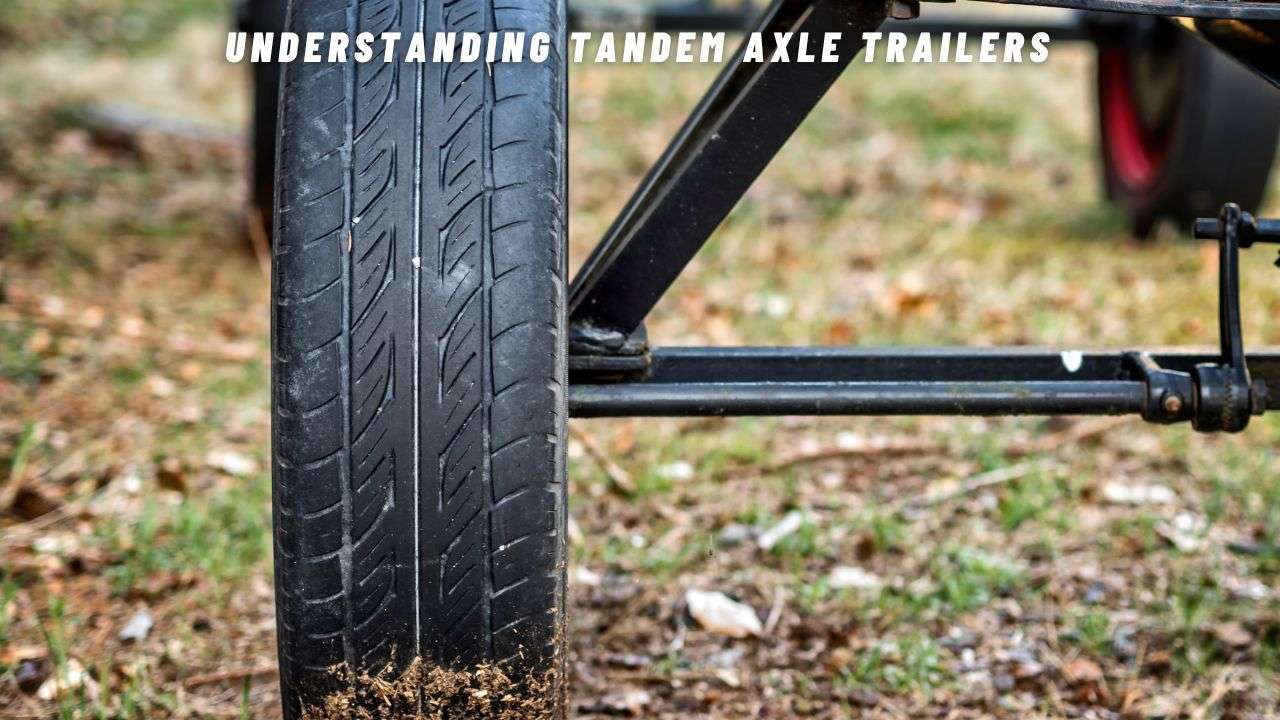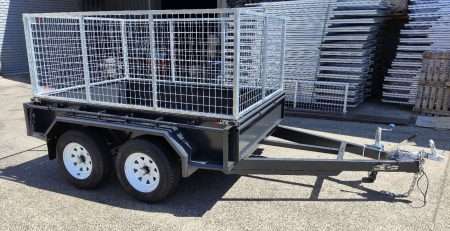
Understanding Tandem Axle Trailers
When it comes to hauling heavy loads, tandem axle trailers are an excellent choice. These trailers are equipped with two axles and four wheels, providing better stability and weight distribution compared to single-axle trailers (Trailer Superstore). Let’s explore what tandem axle trailers are and the benefits they offer.
What are Tandem Axle Trailers?
Tandem axle trailers are trailers that have two axles positioned in tandem, meaning one axle is placed behind the other. Each axle is equipped with two wheels, resulting in a total of four wheels for the trailer. This configuration offers improved weight distribution, stability, and load-carrying capacity.
The weight of the load on a tandem axle trailer is evenly distributed across both axles, reducing the risk of overloading or uneven weight distribution. This ensures safer transportation of goods and reduces the strain on the trailer components.
Benefits of Tandem Axle Trailers
Tandem axle trailers provide several benefits that make them superior for hauling heavy loads. Let’s explore some of these advantages:
- Stability and Weight Distribution: With two axles and four wheels, tandem axle trailers offer enhanced stability and better weight distribution. This reduces the chances of trailer sway and provides a smoother towing experience, especially at higher speeds.
- Weight Capacity and Load Handling: Tandem axle trailers are capable of carrying heavier loads compared to single axle trailers. The additional axle and wheels increase the weight capacity of the trailer, allowing for the transportation of larger and heavier items.
- Braking Efficiency and Control: The braking force is distributed across both axles of a tandem axle trailer, resulting in improved braking efficiency and control. This helps in reducing stopping distances and ensures a safer towing experience.
- Towing Stability and Safety: The presence of two axles provides better stability and control while towing. Tandem axle trailers are less prone to fishtailing and swaying, making them a safer option for transporting goods.
By understanding what tandem axle trailers are and the benefits they offer, you can make an informed decision when choosing a trailer for your hauling needs. Whether you require a tandem utility trailer, tandem boat trailer, or tandem dump trailer, opting for a tandem axle configuration will provide you with the superior hauling capabilities you need.
Tandem Axle Trailers vs. Single Axle Trailers
When it comes to hauling heavy loads, tandem axle trailers offer several advantages over single axle trailers. Let’s explore how tandem axle trailers outperform their single axle counterparts in terms of stability, weight distribution, weight capacity, braking efficiency, and towing safety.
Stability and weight distribution
Tandem axle trailers have two axles and four wheels, providing better stability and weight distribution compared to single-axle trailers (Trailer Superstore). The weight of the load on a tandem axle trailer is distributed evenly across both axles, reducing the risk of overloading or uneven weight distribution. This balanced weight distribution enhances the overall stability of the trailer, allowing for safer and smoother towing.
Weight Capacity and Load Handling
Tandem axle trailers are capable of carrying heavier loads due to their increased weight capacity. The presence of two axles allows for a higher gross vehicle weight rating (GVWR), enabling the trailer to handle larger and heavier loads with ease. This makes tandem axle trailers ideal for transporting heavy equipment, construction materials, or other substantial cargo.
Braking Efficiency and Control
Tandem axle trailers provide better braking efficiency and control compared to single axle trailers. As the braking force is distributed across both axles, the braking system can effectively reduce the speed of the trailer, enhancing overall safety on the road. Particularly during sudden braking situations, the enhanced control that tandem axle trailers provide reduces the risk of skidding or jackknifing.
Towing Stability and Safety
One of the significant advantages of tandem axle trailers is their improved towing stability, especially at higher speeds. The presence of two axles ensures better weight distribution and a lower centre of gravity, reducing the likelihood of trailer sway or fishtailing. This enhanced stability makes tandem axle trailers a safer option for transporting goods over long distances or on highways.
By choosing a tandem axle trailer over a single axle trailer, you can benefit from superior stability, even weight distribution, increased weight capacity, enhanced braking efficiency, and improved towing safety. Whether you’re hauling heavy loads for personal or commercial purposes, tandem axle trailers provide the necessary strength and reliability to get the job done efficiently.
Maintenance and Care for Tandem Axle Trailers
To ensure the optimal performance and longevity of your tandem axle trailer, regular inspections and maintenance are essential. By following a comprehensive maintenance routine, you can keep your trailer in top condition and enhance its safety and reliability.
Regular inspections and maintenance
Tandem axle trailers require regular inspection, maintenance, and service to ensure safe and reliable operation. It is important to develop a maintenance schedule based on factors such as trailer usage, cargo weight, mileage, and environmental conditions. While minimum maintenance recommendations exist, your specific trailer may require more frequent maintenance, depending on these factors.
Here are some key areas to inspect and maintain on a regular basis:
- Brakes: Each time you plan to tow your trailer, thoroughly inspect the brake system. Check for any signs of wear, such as worn brake pads or drums, and ensure proper functioning of the brake lights. If necessary, consult a professional to service or replace the brakes.
- Tyres: Regularly inspect the tyres for proper inflation, tread wear, and any signs of damage. Maintain the proper tire pressure in accordance with the manufacturer’s recommendations to ensure safety and optimal performance. Additionally, check the wheel lug nuts for proper torque to prevent wheel detachment.
- Lights: Check all the trailer lights, including brake lights, turn signals, and taillights, to ensure they are functioning correctly. Replace any burned-out bulbs or faulty wiring connections promptly.
- Coupler: Inspect the trailer coupler for any signs of wear or damage. Ensure that it is securely attached to the towing vehicle and that the locking mechanism functions properly.
Tyre pressure and wheel bearings
Maintaining proper tyre pressure is crucial for tandem axle trailers. Regularly check the tyre pressure and adjust it to the manufacturer’s recommended specifications. Proper tyre inflation helps to optimise load-carrying capacity, fuel efficiency, and tyre longevity.
In addition, pay attention to the wheel bearings. Every six months, inspect and service the wheel bearings and wheel seals to prevent water intrusion, corrosion, and premature wear. Adequate lubrication is essential for smooth wheel rotation and to avoid bearing failures that can lead to accidents or trailer breakdowns.
Brake System and Electrical Components
The brake system and electrical components of your tandem axle trailer also require routine maintenance. Inspect the brake assemblies, including pads, callipers, and drums, for wear and tear. Ensure that the braking system is functioning correctly, and adjust the brakes if necessary.
Inspect the electrical components, such as wiring, connectors, and lights, to ensure they are in good condition. Look for any loose connections, exposed wires, or signs of damage. Regularly clean and lubricate electrical connections to prevent corrosion and maintain reliable operation.
By adhering to a regular maintenance schedule and addressing any issues promptly, you can keep your tandem axle trailer in optimal condition. Remember to consult the manufacturer’s guidelines and seek professional assistance when needed to ensure thorough and effective maintenance.
Stay tuned for the next section, where we will discuss important legal considerations for tandem axle trailers, including weight limits and the impact on roadways and infrastructure.
Legal Considerations for Tandem Axle Trailers
When it comes to tandem axle trailers, it’s important to be aware of the legal considerations associated with their use. Understanding weight limits, the importance of weight distribution, and the impact on roadways and infrastructure is crucial for safe and compliant hauling.
Weight Limits for Tandem Axle Trailers
In the United States, federal regulations specify weight limits for commercial trucks, including tandem axle trailers. According to these regulations, the maximum weight allowed on a single axle is typically 20,000 pounds, while the maximum weight allowed on a tandem axle is 34,000 pounds (source). It’s important to note that weight limits may vary by state, so it’s essential to comply with local regulations when operating a tandem axle trailer.
Importance of Weight Distribution
Proper weight distribution is crucial when using tandem-axle trailers. By distributing the weight of the cargo evenly across multiple axles, the load is better supported, and the risk of damage to the roads and bridges is reduced (source). Imbalanced loads can be dangerous, especially at high speeds, as they can compromise the stability and manoeuvrability of the trailer.
To ensure proper weight distribution, it’s essential to know the weight capacity of your tandem axle trailer. The manufacturer or the trailer’s specifications can both provide this information. By staying within the weight limits and distributing the load evenly, you can avoid potential safety risks and comply with legal requirements.
Impact on Roadways and Infrastructure
The weight of trucks, including tandem axle trailers, can have a significant impact on roadways and infrastructure. Heavy loads can accelerate wear and tear on roads that are already struggling to handle regular traffic volumes. As a responsible haulier, it’s important to consider the potential consequences of exceeding weight limits or improperly distributing the load.
Truck weight limits are enforced for safety reasons, as larger and imbalanced loads can pose a danger to other road users. By adhering to weight limits and ensuring proper weight distribution, you can contribute to the overall safety and integrity of the roadways.
It’s also worth noting that exceeding weight limits without the appropriate permits can result in penalties and fines. It’s essential to familiarise yourself with the weight regulations in your area and obtain any necessary permits to operate a tandem axle trailer within legal limits.
By understanding the weight limits for tandem axle trailers, the importance of weight distribution, and the impact on roadways and infrastructure, you can ensure safe and compliant hauling practices. Always consult local regulations and adhere to weight limits to contribute to the safety and integrity of the transportation system.
Author
I am Rahatul Ashiq Tamal. Another author of Muscle Trailers. Muscle Trailers is a well-known trailer brand in Sydney, Melbourne & Adelaide

How to Mount a Spare Tire on Your Trailer: A Simple Step-by-Step Guide
Trailer service centers receive over 1 million phone calls and 1.3 million emails each year about trailer maintenance problems....

How to Fix RV Roof Leaks: Simple Roof Leak Detection Guide for Beginners
Did you know DIY RV roof repairs can cost under $50? But undetected leaks could lead to substantially higher repair...

Starting a Food Truck Business in Australia: From Trailer Selection to Launch
The Australian mobile food market has evolved into a billion-dollar industry. This makes a food truck...
